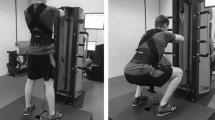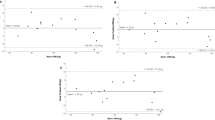Abstract
The purpose of this study was to describe the force/velocity and power/velocity relationships obtained during squat exercise. The maximal force (F 0) was extrapolated from the force/velocity relationship and compared to the isometric force directly measured with the aid of a force platform placed under the subject's feet. Fifteen international downhill skiers [mean (SD) age 22.4 (2.6) years, height 178 (6.34) cm and body mass 81.3 (7.70) kg] performed maximal dynamic and isometric squat exercises on a guided barbell. The dynamic squats were performed with masses ranging from 60 to 180 kg, which were placed on the shoulders. The force produced during the squat exercise was linearly related to the velocity in each subject (r 2=0.83–0.98, P < 0.05–0.0001). The extrapolated F 0 was 23% higher than the measured isometric force (P < 0.001), and the two measurements were not correlated. This may be attributed to the position of the subject, since the isometric force was obtained at a constant angle (90° of knee flexion), whereas the dynamic forces were measured through a range of movements (from 90° to 180°). The power/velocity relationship was parabolic in shape for each subject (r 2=0.94–0.99, P < 0.01–0.0001). However, the curve obtained exhibited only an ascending part. The highest power was produced against the lightest load (i.e., 60 kg). The maximal power (W˙ max ) and optimal velocity were never reached. The failure to observe the descending part of the power/velocity curve may be attributed to the upper limitation of the velocities studied. Nevertheless, the extrapolation of W˙ max from the power/velocity equation showed that it would be reached for a load close to body mass, or even under unloaded conditions.
Similar content being viewed by others
Author information
Authors and Affiliations
Additional information
Accepted: 19 September 2000
Rights and permissions
About this article
Cite this article
Rahmani, A., Viale, F., Dalleau, G. et al. Force/velocity and power/velocity relationships in squat exercise. Eur J Appl Physiol 84, 227–232 (2001). https://doi.org/10.1007/PL00007956
Issue Date:
DOI: https://doi.org/10.1007/PL00007956




